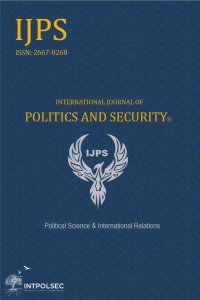The Positivity of Peace Intra-and Inter-State: Strategizing the Balance of Peace-State in Multi-Level Conflict Management Approach
Hiper Oyun Teorisi, Post-Yapısalcılık, Kültür Endüstrisi, İnşacılık, Nash Dengesi
The Positivity of Peace Intra-and Inter-State: Strategizing the Balance of Peace-State in Multi-Level Conflict Management Approach
___
- Adorno, T. (1991). (Review of the book The Culture Industry: Selected Essays on Mass Culture). London: Routledge. Retrieved from https://pdfs.semanticscholar.org/6ce6/efebe19f39df7f016751b85cfad107a1e306.pdf
- Althusser, L., Ideology and Ideological State Apparatuses (Notes Towards an Investigation). in Durham, M. G., and Kellner, D. M. (2001, 2006). Media and Cultural Studies: Keyworks (Rev. ed.). USA, UK, and Australia: Blackwell Publishing.
- Butler, M. J. (2009). International Conflict Management. United Kingdom: Routledge.
- Cox, M., and Campanaro, R. (2016). Introduction to International Relations. London: University of London.
- Efegil, E. (2019). Devlet-İçi Çatımalar ve Çatışma Yönetimi (Intra-State Conflicts and Conflict Management). Istanbul: Gündoğan Yay.
- Foucault, M. (1977) Discipline and Punish: The Birth of the Prison, trans. Alan Sheridan. New York: Pantheon Books.
- Foucault, M. (1989). The Archaeology of Knowledge. London: Routledge.
- Garnham, N. (2005). From Cultural to Creative Industries: An Analysis of the Implications of the “Creative Industries” Approach to Arts and Media Policymaking in the United Kingdom. International Journal of Cultural Policy, 11(1): 15-29.
- Gavra, D. P. & Savitskaya, A. S. (2011). Mass Media in Interstate Conflicts: Typological Model “Peace-conflict Journalism Multidimensional Approach.” Russian Journal of Communication, 4(3-4), 251-265.
- Gilboa, E. (2001). Diplomacy in the Media Age: Three Models of Uses and Effects. Diplomacy and Statecraft, 12(2), 1-28.
- Greiff, J. L., Bricker, M. G., Gamaghelyan, P., Tadevosyan, M. & Deng, S. (2015). Debriefing in Peacemaking and Conflict Resolution Practice: Models of Emergent Learning and Practitioner Support. Reflective Practice, 16(2), 254-268.
- Hofmann, C., & Schneckener, U. (2011, September). Engaging non-state armed actors in state and peace-building: options and strategies. International Review of the Red Cross, 93(883), 603-621.
- Hobbes, T. (1651, 1996). Leviathan. (Ed. J. C. A. Gaskin). USA: Oxford University Press.
- Horkheimer, M., & Adorno, T. W., The Culture Industry: Enlightenment as Mass Deception. Durham, M. G., & Kellner, D. M. (2001, 2006). Media and Cultural Studies: Keyworks (Rev. ed.). USA, UK, and Australia: Blackwell Publishing.
- Jespersen, J. L., Albrechtslund, A., Øhrstrøm, P., Hasle, P., & Albretsen, J. (2007). Surveillance, Persuasion, and Panopticon. PERSUASIVE 2007, LNCS 4744, (pp. 109-120).
- Jones, S. (2006). Routledge Critical Thinkers: Antonio Gramsci. Eaglestone, R. (Ed.). USA, and Canada: Routledge.
- Kovach, N. S., Gibson, A. S., and Lamont, G. B. (2015). Hypergame Theory: A Model for Conflict, Misperception, and Deception. Game Theory, Vol. (2015), pp. 1-20.
- Laughey, D. (2007). Key Themes in Media Theory. England: Open University Press.
- Morgenthau, H. J., (1948). Politics Among Nations: The Struggle for Power and Peace. Ed. 1. New York: Alfred A. Knopf.
- Newman, E. & Richmond, O. (2006). Obstacles to peace processes: Understanding spoiling. In Challenges to Peacebuilding: Managing Spoilers During Conflict Resolution. New York (USA): United Nations University Press.
- Richmond, O. P. (2008). Peace in International Relations. United Kingdom: Routledge.
- Svensson, I. (2009, June). Who Brings Which Peace? Neutral versus Biased Mediation and Institutional Peace Arrangements in Civil Wars. Journal of Conflict Resolution, 53(3), 446-469.
- Waltz, K. N., (1979). Theory of International Politics. Ed.1. United States of America: McGraw-Hill.
- Zagare, F. C. (2019). Game Theory, Diplomatic History, and Security Studies. The United Kingdom, and New York: Oxford University Press.
- Zagare, F. C., and Slantchev, B. L. (2021). Game Theory and Other Modeling Approaches. Oxford Research Encyclopedias: International Studies Association and Oxford University Press. Retrieved from https://doi.org/10.1093/acrefore/9780190846626.013.401
- Zahar, M. J. (2006). Understanding the Violence of Insiders: Loyalty, Custodians of Peace, and the Sustainability of Conflict Settlement. In Newman, E. & Richmond, O. (Ed.), Challenges to Peacebuilding: Managing Spoilers During Conflict Resolution. New York (USA): United Nations University Press.
- ISSN: 2667-8268
- Yayın Aralığı: Yılda 2 Sayı
- Başlangıç: 2019
- Yayıncı: Fikret BİRDİŞLİ
The Issue of Political Recognition in International Policy: The Case of Kosovo
Emerging Cyber Security Threats: India’s Concerns and Options
Transformation of Israeli Security Organizations after the Yom Kippur War
Semine Seray GÜLDANE, Ahmet ATEŞ
Turkey’s Preventive Operations against Terrorists across Southern Border
